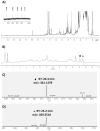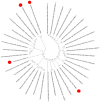Antitumor Anthraquinones from an Easter Island Sea Anemone: Animal or Bacterial Origin?
- PMID: 30841562
- PMCID: PMC6471592
- DOI: 10.3390/md17030154
Antitumor Anthraquinones from an Easter Island Sea Anemone: Animal or Bacterial Origin?
Abstract
The presence of two known anthraquinones, Lupinacidin A and Galvaquinone B, which have antitumor activity, has been identified in the sea anemone (Gyractis sesere) from Easter Island. So far, these anthraquinones have been characterized from terrestrial and marine Actinobacteria only. In order to identify the anthraquinones producer, we isolated Actinobacteria associated with the sea anemone and obtained representatives of seven actinobacterial genera. Studies of cultures of these bacteria by HPLC, NMR, and HRLCMS analyses showed that the producer of Lupinacidin A and Galvaquinone B indeed was one of the isolated Actinobacteria. The producer strain, SN26_14.1, was identified as a representative of the genus Verrucosispora. Genome analysis supported the biosynthetic potential to the production of these compounds by this strain. This study adds Verrucosispora as a new genus to the anthraquinone producers, in addition to well-known species of Streptomyces and Micromonospora. By a cultivation-based approach, the responsibility of symbionts of a marine invertebrate for the production of complex natural products found within the animal's extracts could be demonstrated. This finding re-opens the debate about the producers of secondary metabolites in sea animals. Finally, it provides valuable information about the chemistry of bacteria harbored in the geographically-isolated and almost unstudied, Easter Island.
Keywords: Actinobacteria; Easter Island; anthraquinones; chromatography; marine invertebrates; sea anemone; spectroscopy; symbionts.
Conflict of interest statement
The authors declare no conflict of interest.
Figures






References
-
- Dransfield J., Flenley J.R., King S.M., Harkness D.D., Rapu S. A recently extinct palm from Easter Island. Nature. 1984;312:750. doi: 10.1038/312750a0. - DOI
-
- Boyko C.B. The endemic marine invertebrates of Easter Island: How many species and for how long? In: Loret J., Tanacredi J.T., editors. Easter Island: Scientific Exploration into the World’s Environmental Problems in Microcosm. Springer; Boston, MA, USA: 2003. pp. 155–175.
-
- Skottsberg C. The Natural History of Juan Fernández and Easter Island. Almqvist & Wiksells Boktryckeri; Uppsala, Sweden: 1920.
-
- Kohn A.J., Lloyd M.C. Marine polychaete annelids of Easter Island. Int. Rev. Hydrobiol. 1973;58:691–712. doi: 10.1002/iroh.19730580508. - DOI
MeSH terms
Substances
LinkOut - more resources
Full Text Sources

